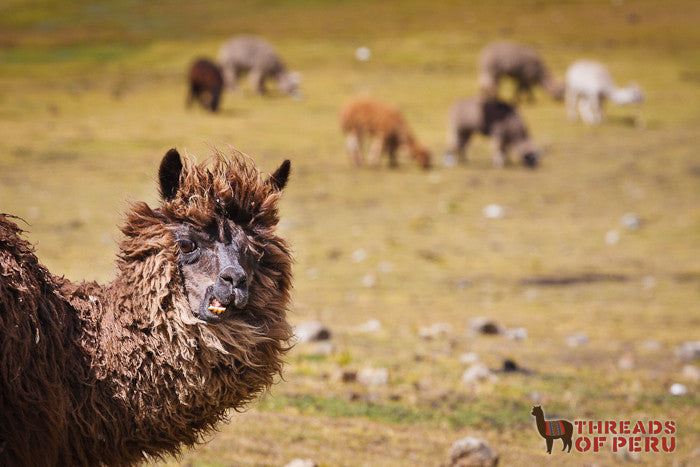Imagine you are walking through the Andean highlands and you come across a herd of wooly creatures with long necks that vaguely resemble camels. Is that a llama? No, maybe an alpaca? Which one is it? Don’t worry, in today’s blog post we are going to help you sort it out.

First off, why should you care? The simple answer is, if you are into textiles like we are, alpacas produce wonderful fine wool, perfect for ponchos or scarves. Llamas on the other hand have coarser wool that is better suited to things like rugs or ropes. Many of the products Threads of Peru sells come from alpacas; none come from llamas.

Sorry llamas, this goof-ball has got you beat.
This fine-versus-rugged distinction is a good way to remember who is who. Llamas are larger and their sturdy frames made them the Andean people’s go-to method of cargo transportation until they were replaced first by mules and then by trucks. Even though the llama no longer carries the majority of Peru’s goods, it is still an important pack animal in the highlands.
Alpacas are smaller and don’t have the strength of their larger cousins but they serve an important role as a source of wool and occasionally meat. The wool from Alpacas is noted for its soft texture and the Suri breed has one of the finest fibers of any mammal.

The Alpaca: king of Peruvian fashion.
So, how do you tell them apart? The first give away is the size. Alpacas are slightly smaller than llamas. They also have thicker wool that makes them appear more stocky. If it is short and stocky it is probably an alpaca. If it is tall and lanky, odds are it is a llama. However, when the alpaca loses all its wool to the shearer, the distinction is less clear.
When both animals have their coats, the alpacas dense wool gives it a “puffy” appearance — think cotton balls. The llamas coat is more sparse and looks more like a shaggy dog than a sheep. The wool on the alpaca tends to grow thick even on their faces where sometimes it covers their eyes. This gives their heads a shorter, rounder look than the llama which tends to have a more lengthy snout.

Don't worry llamas, you're still pretty majestic.
Some people say you can tell the animals apart by looking at their ears. They say the llama has longer crescent shaped ears while the alpacas are short and pointed. In practice though, it is a subtle difference and one that can be hard to spot.
Now you know what to look for and the next time you see a wooly creature with a long neck in the Andes, you will know what it is — or you will know what it is unless it is a wild guanaco or vicuña, but that is a story for a different time.

